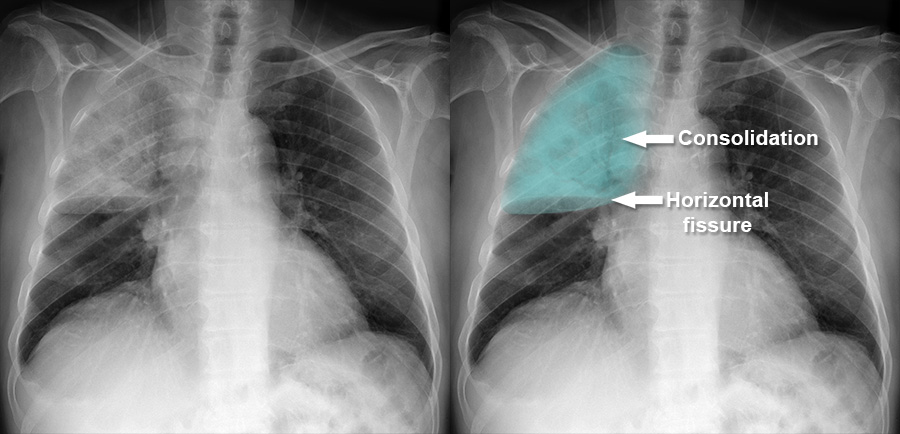10 facts about pneumonia
In this article we will describe 10 facts about pneumonia, focussing on its symptoms, causes, and treatment.
Let’s start with the basics.

Right upper lobe pneumonia
Pneumonia is infection and/or inflammation in lung tissue. It’s usually caused by a bacteria.
1. Definition
Pneumonia is a lower respiratory tract infection (LRTI) where there is new radiological consolidation – in one or both lungs – on chest x-ray. There is inflammation in the air sacs, which fill with pus or fluid. This leads to coughing (usually with yellow-green sputum), fever, rigors; and in some, difficulty breathing and shortness of breath.
2. Causes
Pneumonia can be caused by various infectious agents, including:
- Bacteria (e.g. Streptococcus pneumoniae)
- Viruses (e.g. influenza, SARS-CoV-2)
- Fungi (e.g. Pneumocystis jirovecii)
- Parasites.
3. Classification
There are various classification systems based on: 1. anatomy (which part of lung is affected); 2. cause (microorganism); and 3. where it is acquired (community, hospital etc).
In the latter, pneumonia is classified into different types based on where it was acquired: community-acquired pneumonia (CAP), hospital-acquired pneumonia (HAP), healthcare-associated pneumonia (HCAP), and ventilator-associated pneumonia (VAP).
4. Symptoms
Common symptoms include cough (often producing yellow/green sputum +/- haemoptysis), pleuritic chest pain (on inspiration, moving and coughing), fever, rigors, shortness of breath, fatigue, and muscle aches. In severe cases, it can cause acute confusion, particularly in older adults.
Course of pneumonia
The symptoms of pneumonia can develop rapidly over 4-6 hours, or they may come on more slowly over several days.
Most people get better in 2 to 4 weeks; but babies, older people, and people with heart or lung conditions are at risk of getting seriously ill, and may need treatment in hospital.
5. Risk factors
Certain groups are at higher risk for pneumonia, including infants and young children, elderly individuals, people with chronic illnesses (e.g. COPD, diabetes), people who smoke or use alcohol excessively, and those with weakened immune systems.
6. Diagnosis
Pneumonia is diagnosed through a combination of medical history, physical examination, chest x-ray (essential), blood tests, sputum culture – and sometimes CT scan or bronchoscopy to identify the specific cause.
7. Treatment
Treatment depends on the cause. Bacterial pneumonia is treated with antibiotics (oral or intravenous), whilst viral pneumonia is usually be managed with supportive care (and sometimes antiviral medication). Fungal pneumonia requires antifungal drugs. General supportive care includes rest, fluids, and paracetamol/NSAIDs to relieve symptoms.
Mild cases can be cared for at home, with regular review. More serious cases require hospital admission.
8. Complications
Complications of pneumonia include pleural effusion (fluid accumulation around the lungs), lung abscess, and sepsis (which can be life-threatening).
9. Prevention
Vaccinations can prevent some types of pneumonia, such as pneumococcal vaccines for bacterial pneumonia, and annual flu vaccines to prevent influenza pneumonia. Good hygiene practices, smoking cessation, and avoiding close contact with sick individuals can also reduce the risk.
10. Global impact
Pneumonia is a leading cause of morbidity and mortality worldwide, particularly among children under five and older adults. According to the World Health Organization (WHO), pneumonia accounts for approximately 15% of all deaths of children under five years old globally.
Summary
We have described 10 facts about pneumonia, and its symptoms, causes, and treatment. We hope it has been helpful.

